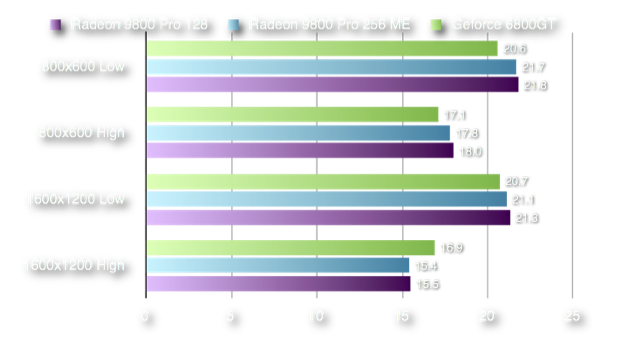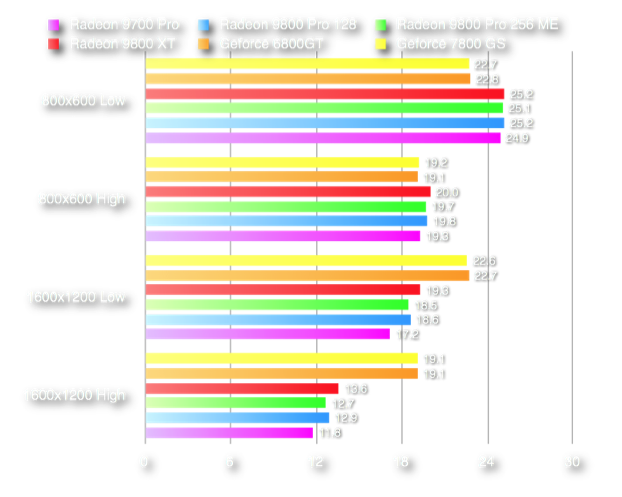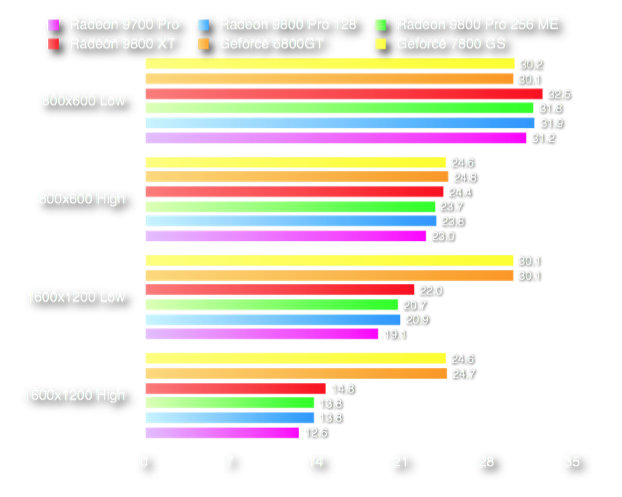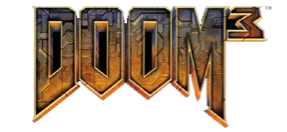







Doom 3 Performance
Publisher: Aspyr Media

Minimum System Requirement:
Mac OS X: 10.3.8 and later
CPU: G4 @ 1.5 GHz  RAM: 512 MB
RAM: 512 MB  Hard Disk: 2 GB
Hard Disk: 2 GB  Graphics: 64 MB VRAM*
Graphics: 64 MB VRAM*
 RAM: 512 MB
RAM: 512 MB  Hard Disk: 2 GB
Hard Disk: 2 GB  Graphics: 64 MB VRAM*
Graphics: 64 MB VRAM**Radeon 9600 or Geforce 5200 minimum
__________________________________________
I have always enjoyed Doom 3. In fact, one of the over riding reasons for adding a processor upgrade to my Sawtooth was so that I could play Doom 3.
Doom 3 is a visually intense, visceral game, and still, even now, occasionally startles me!

This first series of tests uses a Quicksilver 2002 933 MHz, 1.5GB RAM equipped machine, and the 23” Apple Cinema Display. Yes, under the MSR for the game, but, I don’t care.....
__________________________________________
Doom 3 - 933 MHz G4 - OS X 10.5.6 - Test: Timedemo - Full Screen - Scores in Frames per Second (fps).

What I figured out a while back, was that with some games, even though the processor may be slower than the specified system requirement, a high performance graphics card can help overcome the processors limitations.
Though not great fps performance, the rates are still high enough to make the game playable, and enjoyably so.
__________________________________________
On a whim during other testing, I decided to compare the performance of a software between OS X 10.5 and OS X 10.4.
Some software will show minor differences, others quite pronounced. The QS 933 MHz G4 in OS X 10.4.11 with Doom 3 showed that Tiger and Leopard offer performance differences, and these differences vary yet between Geforce and Radeon cards.
Doom 3 - 933 MHz G4 - OS X 10.4.11 - Test: Timedemo - Full Screen - Scores in Frames per Second (fps).

The main point of this illustration is that when tweaking for maximum performance, nothing should be left to chance.
Also, compromises may need to be made, or multiple OS versions maintained.
Back to the results.....
Though low resolution scores aren’t terrible, I was surprised at how much better the Radeon cards scored than the Geforce cards, especially at Low settings. Believe me, I quadruple checked this, as I expected the Geforce to be stronger in all tests, regardless of OS.
Then came the change in resolution, and Bingo! The Geforce cards started to their stuff. From here, I decided to do some more tweaking.
Working with the three cards used in the leopard tests, with advanced settings at “Shadows: No” and “HQ Special Effects: No”, the Geforce 6800 GT managed 22.8 fps at any resolution in Tiger. Neither of the 9800 scores improved.
Removing “Specular” the Geforce pumps 23.8 fps, and the Radeon cards, again, are unchanged. Doom 3 without Specular, though, is not as appealing as with, so that option is better left “On”.
Doom 3 is still a visually absorbing game without the HQSFX.
With any of the 3 cards, the decrease in visual quality without the HQSFX is not distractingly reduced. The Geforce game play is smooth, a stark comparison to the Radeon cards, which tended to be jerky, even in the strongest 800x600 Low settings. The game is very playable at low resolution with the Radeon cards though.
It is interesting to note that changing the HQ Special Effects settings did nothing to improve the Radeon cards performance at any resolution.
In actual gameplay, although the Radeon cards proved to be the fps winners, the Geforce cards makes Doom 3 very playable in spite of the processor not meeting minimum system requirements for the game.
The real bonus is that both the Geforce 6800 GT and 7800 GS hold their own through the highest resolutions, which further add to the visual intensity of the game.
It seems the power of the Geforce makes up for the weak processor, and is a winner with Doom 3.
Though gameplay with the Geforce cards is smooth in both Tiger and Leopard, Tiger offers the better gaming experience.
Next, we bump the processor up to 2.0 GHZ.........

For this next set of tests, we have a 2.0 GHz 7447A processor in a Quicksilver 2002, using 1.5GB RAM and a WD5000AAKB PATA drive, booted to OS X 10.4.11.
BTW, the same MOBO, RAM and hard drive are used in all tests in an attempt to eliminate variables.
Doom 3 - 933 MHz G4 - OS X 10.4.11 - Test: Timedemo - Full Screen - Scores in Frames per Second (fps).

It’s easy to see that a bit more processor helps with the performance.
At low resolutions, all cards give excellent results, with the Radeon cards out showing the Geforce cards in low quality settings. The Radeon 9800 XT makes a nice showing with 32.5 fps.
When it comes to high resolutions, though, the Radeon cards fall flat, and the Geforce cards give the same frame rates as in lower resolution tests.
Of note, is the 6800 GT, which doesn’t bow down to the reputation of the 7800 GS as the “fastest AGP card”.
Also of note is the difference in a cards performance in Tiger and in Leopard.
The Radeon cards may perform better in the high resolution tests in Leopard as compared to Tiger, but it is not enough to place them in the same performance category of the two Geforce cards.
All in all, the numbers aren’t bad for a lowly G4.......



